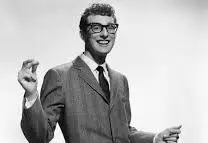Here’s a concise History of Buddy Holly and his song:
https://www.youtube.com/watch?v=bfWouiyE5FU
Buddy Holly: A Brief Biography
- Birth Name: Charles Hardin Holley
- Born: 7 September 1936, in Lubbock, Texas
- Died: 3 February 1959, in a plane crash during the Winter Dance Party tour (the tragedy often called “The Day the Music Died”).
- Holly was a pioneer of rock and roll, influencing artists like The Beatles and The Rolling Stones. His hits include “That’ll Be the Day,” “Peggy Sue,” and “Everyday.”
“True Love Ways”: Origins and Recording
- Written by: Buddy Holly and Norman Petty
- Purpose: Holly reportedly wrote it as a wedding gift for his wife, Maria Elena Santiago Holly, whom he married in August 1958.
- Recording Date: 21 October 1958, at Decca’s Pythian Temple Studio in New York City. This was Holly’s final studio session before his death.
- Arrangement: Conducted by Dick Jacobs with an 18-piece orchestra (strings, harp, saxophone, piano, and rhythm section). This session marked Holly’s shift from rock ’n’ roll toward lush, orchestral pop.
- Release: Posthumously in March 1960 on The Buddy Holly Story, Vol. 2. It charted modestly in the UK (#25) but not in the US.
Musical and Emotional Significance
- The melody was inspired by the gospel hymn “I’ll Be All Right,” a favorite of Holly’s and later played at his funeral.
- Lyrics express enduring love, acknowledging both joy and sorrow in a relationship—“sometimes we’ll sigh, sometimes we’ll cry.”
- The song’s tender tone and orchestral backing contrast with Holly’s earlier rock hits, showing his versatility and artistic growth.
Legacy and Covers
- Covered successfully by Peter & Gordon (1965, UK #2, US #14), Mickey Gilley (1980, US Country #1), and Cliff Richard (1983, UK Top 10).
1. Core Theme
“True Love Ways” is a romantic ballad that emphasizes enduring love and emotional honesty. The phrase “true love ways” suggests that genuine love has its own path—sometimes joyful, sometimes sorrowful—but always authentic.
2. Emotional Tone
- Tender and reassuring: The song conveys calm intimacy rather than passionate urgency.
- Acknowledgment of life’s ups and downs: It recognizes that love encompasses both happiness and hardship, deepening the commitment.
3. Structure and Progression
- Opening lines: They set a reflective mood, almost like a spoken promise.
- Middle section: Introduces the idea that love is not static; it evolves through shared experiences—both laughter and tears.
- Closing sentiment: Affirms that these experiences are part of the “true love ways,” reinforcing the theme of acceptance and devotion.
4. Literary Devices
- Contrast: Joy vs. sorrow, laughter vs. tears—underscoring the completeness of love.
- Repetition: Certain phrases recur to create a soothing, mantra-like effect.
- Direct address: Feels personal, as if Holly is speaking directly to his wife.
5. Musical Complement
The orchestral arrangement amplifies the lyrics’ emotional depth. Strings and harp create a warm, romantic atmosphere, aligning with the song’s message of lasting love.
Because they’re copyrighted, but I can break them down conceptually, line by line, based on their meaning and emotional intent:
Opening Lines
- Interpretation: The song begins with a gentle, almost conversational reassurance, setting a tone of calm intimacy. Holly is affirming that love is real and worth cherishing.
First Verse
- Meaning: These lines express that love is not just about joy—it includes moments of sadness. Holly acknowledges that true love involves both laughter and tears, which makes the bond authentic.
Middle Section
- Theme: Here, Holly emphasizes the permanence of love. He suggests that even when circumstances change, the emotional connection remains strong. This section feels like a promise of loyalty.
Closing Lines
- Message: The final lines reaffirm that these experiences—both good and bad—are part of the “true love ways.” It’s a philosophical acceptance of love’s complexity, ending on a hopeful, tender note.
